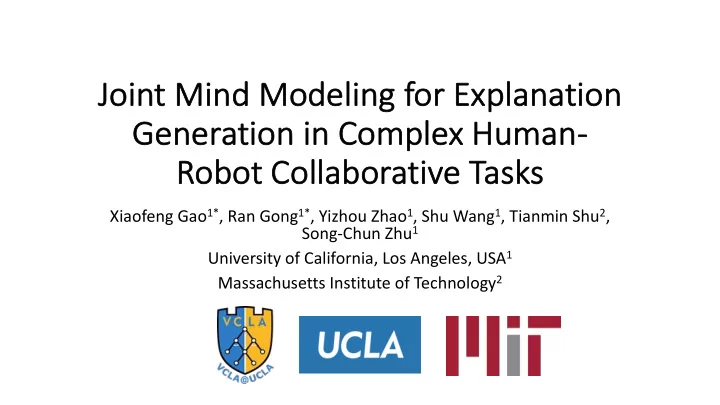

Joi Joint Mi Mind Mo Modeling fo for Ex Explana planatio ion Gener Generatio ion in in Co Complex x Human- Ro Robot Co Collaborative Ta Tasks Xiaofeng Gao 1* , Ran Gong 1* , Yizhou Zhao 1 , Shu Wang 1 , Tianmin Shu 2 , Song-Chun Zhu 1 University of California, Los Angeles, USA 1 Massachusetts Institute of Technology 2
Motivation • Humans can work towards a common goal even though one doesn’t know the exact details of the task • Communication is necessary for coordination • Efficient communication comes from inferring other’s belief, desire, or intention
Collaborative Cooking Game • Task Example: making apple juice with 3 apples • A Task Plan: Robot • Take each apple from the basket • Put it onto chopping board and cut it Human • Put it into a juicer • Use the juicer • Pour the juice into a bowl • Deliver the juice • Sub-tasks dependency For better task performance, how should the robot coordinate with non-expert users?
Task Allocation by Mixed-Integer Linear Programming Machine plans to do itself What Machine expects user to do For task allocation, we minimize the amount of time for the slower agent to finish the task, with respect to variables: Binary decision variable 𝑦 : whether to assign a “task” to an agent 𝑤 • Continuous timing variable 𝑢 : the time that a certain atomic action is • performed Constraint: generated based on causal and temporal structure of task •
Explanation framework • Planning • To get an initial joint plan • Inference • Explanation • Re-planning • To comply with suboptimal user behaviors
Human mental model inference • Bayesian inference of user subtasks $ • We consider communication history 𝗇 and observed user action 𝑏 !"# independently in the likelihood likelihood of Similarity between partially sampled trajectory observed trajectory and sampled trajectory
Inferring human intention/plan based on observations • Sampled trajectories • Observed Trajectories Robot Based on the distance between $ $ 𝑏 !"# and 𝑏 #%&' , a reasonable prediction of user’s action would be “taking the bowl” Taking apple Taking bowl Human Using knife
Explanation generation Explanation content: How much to say • By modeling user’s task plan pg UinM , the machine can give detailed explanations to improve the task performance, i.e. the machine can communicate the current subtasks and atomic actions of both agents Explanation timing: When to say • By modeling user’s task plan pg UinM during collaboration, the machine can generate explanations at a more appropriate time, i.e. when the expected user subtasks are different from the inferred subtasks.
Example: make apple juice with 3 apples
Experiment Procedure N=27, non-expert users Introduction Familiarization Testing Evaluation No Explanation Control An introduction of Asking users to the experiment. Explain when there is finish a simple task Post experiment Heuristics no detected user action Showing an to help them get survey explanation familiar with the template. control. Explanation generated Mind Modeling by the algorithm at the proposed timing.
Experiment Result on 2 Hypotheses H1: Using explanations generated by the *: p < .05 proposed algorithm would lead to more fluent **: p<.01 teamwork • Task completion time H2: Participants under different testing conditions would have different levels of perceptions of explanations, indicated by the * subjective measures • Efficiency • Helpfulness ** ** * • Confirmed H1 and H2 * • Take-away Message: with proper communication between human and machine, both the task performance and user’s perception about the machine can be improved.
Limitations and future work • Task and environment • Shared workspace • Diverse strategies • Balanced roles for the human and machine • Explanation content • Identify the problem • Tailored to the user’s need “Robots Make Bavarian Breakfast Together.” IEEE Spectrum
Any questions? For more information, contact Xiaofeng Gao (xfgao@ucla.edu).
Recommend
More recommend